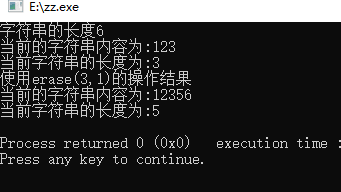C++STL容器---String字元容器
阿新 • • 發佈:2019-01-14
C語言只是提供了Char來處理字元,對於字串來說,只能通過字串陣列來處理,十分不方便.C++ STL提供了一個string容器來處理字串,可以進行新增和刪除和替換等等。用我們家鄉話來說就是“真不孬!"
一、操作函式
s.length();//返回字串的長度
s.append();//在尾部新增相應的字串
s.insert(index,字元);//向字串s的某個位置插入特定字元
s.empty();//判斷字串是否為空
s.replace(位置,距離,“替換的字串");//從特定位置開始將特定距離的字串替換為字串
s.find('字元');//在s中尋找字元的位置
s.compare("字串");//相等返回0,如果大於,返回1,小於返回-1
reverse(s.begin(),s.end());//反向排序,倒敘
s.assign(str2,4,3);//將str2的索引為4距離為3的子串賦值給s
s.erase(索引開始,距離);//刪除相對應的子串
s.swap(str);//將兩個字串交換
二、程式碼解釋
1、對於erase和length使用
#include<string> #include<iostream> using namespace std; int main() { string s("123456"); cout<<"字串的長度"<<s.length()<<endl; s.erase(3); cout<<"當前的字串內容為:"<<s<<endl; cout<<"當前字串的長度為:"<<s.length()<<endl; s="123456"; s.erase(3,1);//位置+距離 cout<<"使用erase(3,1)的操作結果"<<endl; cout<<"當前的字串內容為:"<<s<<endl; cout<<"當前字串的長度為:"<<s.length()<<endl; return 0; }
執行結果為:
2、對於replace函式的使用
#include<string> #include<iostream> using namespace std; int main() { string s("123456"); cout<<"當前的字串內容為:"<<s<<endl; s.replace(3,3,"nihao"); cout<<"使用replace(3,3,"<<"nihao)"<<"的操作結果"<<endl; cout<<"當前的字串內容為:"<<s<<endl; cout<<"當前字串的長度為:"<<s.length()<<endl; return 0; }
執行結果為:

3、對於find函式的使用
#include<string>
#include<iostream>
using namespace std;
int main()
{
string s("123456");
cout<<"當前的字串內容為:"<<s<<endl;
cout<<"2的位置"<< s.find('2')<<endl;
cout<<"4的位置"<<s.find('4')<<endl;
cout<<s.compare("1234567")<<endl;
return 0;
}
執行結果:

4、對於字串的新增函式append和insert
#include<string>
#include<iostream>
using namespace std;
int main()
{
string s("123456");
cout<<"當前的字串內容為:"<<s<<endl;
s.append("78");
s.insert(0,"0");
cout<<"修改之後的字串內容為:"<<s<<endl;
return 0;
}
執行結果:

5、對於翻轉函式reverse的使用
#include<string>
#include<iostream>
#include<algorithm>
using namespace std;
int main()
{
string s("123456");
cout<<"當前的字串內容為:"<<s<<endl;
reverse(s.begin(),s.end());
cout<<"修改之後的字串內容為:"<<s<<endl;
return 0;
}
執行結果:

三、其他方面
對於使用printf函式輸出字串應該使用s.c_str()
#include<string>
#include<math.h>
#include<iostream>
#include<stdio.h>
using namespace std;
int main()
{
string s;
char ss[100];
scanf("%s",&ss);
s=ss;
printf("%s",s.c_str());
cout<<endl;
printf("%s",ss);
cout<<endl;
cout<<s<<endl;
return 0;
}
同時string 又可以作為vector的向量元素
#include<string>
#include<math.h>
#include<iostream>
#include<stdio.h>
#include<vector>
using namespace std;
int main()
{
vector<string> v;
v.push_back("zhangyang");
v.push_back("hoho");
v.push_back("1232");
cout<<v[0]<<endl;
cout<<v[1]<<endl;
cout<<v[2]<<endl;
}sscanf可以將字串格式化分割
#include<string>
#include<math.h>
#include<iostream>
#include<stdio.h>
#include<vector>
using namespace std;
int main()
{
string s1,s2,s3;
char sa[100],sb[100],sc[100];
sscanf("abc 123 pc","%s %s %s",sa,sb,sc);
s1=sa;
s2=sb;
s3=sc;
cout<<s1<<" "<<s2<<" "<<s3<<" "<<endl;
int a,b,c;
sscanf("1 2 3","%d %d %d",&a,&b,&c);
cout<<a<<" "<<b<<" "<<c<<endl;
int x,y,z;
sscanf("4,5$6","%d,%d$%d",&x,&y,&z);
cout<<x<<" "<<y<<" "<<z<<endl;
return 0;
}字串與數字的轉換
#include<iostream>
#include<cstdio>
#include<string>
#include<sstream>
using namespace std;
string convertTostring(double x)
{
ostringstream o;
if(o<<x)
return o.str();
return "conversion error";
}
double convertFromString(const string &s)
{
istringstream i(s);
double x;
if(i>>x)
return x;
return 0.0;
}
int main()
{
char b[10];
string a;
sprintf(b,"%d",1975);
a=b;
cout<<a<<endl;
string cc=convertTostring(1976);
cout<<cc<<endl;
string dd="2006";
int p=convertFromString(dd)+2;
cout<<p<<endl;
return 0;
}
